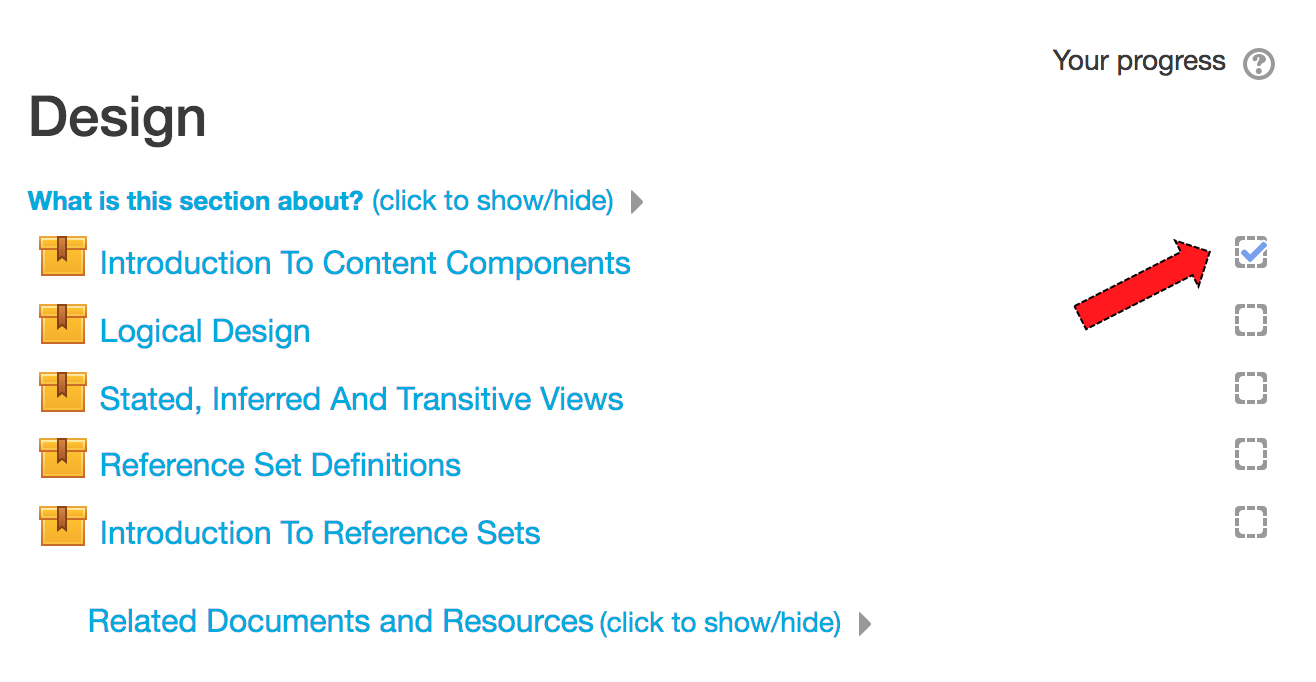Introduction to E-Learning Pathway for Developers
| Site: | SNOMED CT E-Learning Platform |
| Course: | Course Information |
| Book: | Introduction to E-Learning Pathway for Developers |
| Printed by: | Guest user |
| Date: | Thursday, 1 January 2026, 6:24 AM |
1. Background

Welcome to SNOMED CT for Developers! We hope you enjoy following this learning pathway and learning about how to leverage the capabilities of SNOMED CT in your software applications!
When implemented in a well designed software application, SNOMED CT can be used to represent clinically relevant information consistently, reliably and comprehensively. There are many reasons to use SNOMED CT when developing clinical software applications, including:
- SNOMED CT represents clinical semantics in a computable form which can be leveraged in your software application.
- SNOMED CT supports synonyms and dialect-specific descriptions which in turn support multi-lingual user interfaces and customization.
- SNOMED CT is distributed in tab-delimited files that can be loaded into any data store. This provides a wide range of technology options.
- SNOMED CT is regularly updated and has comprehensive versioning of each terminology component.
- SNOMED CT enables meaning-based data analytics using formal description logic definitions of clinical concepts.
The features of SNOMED CT enable applications to be developed with:
- Improved user interface design,
- Data that is captured in a human readable form and then stored in a computable form,
- Point of care services, such as clinical decision support,
- Common code system for integrating and sharing data, and
- Data analytics features which facilitate population health management and clinical research.
2. Purpose

The key objective of the “SNOMED CT for Developers” learning pathway is to teach you enough about SNOMED CT, in as short as possible a time, to enable you to develop software applications which leverage the capabilities of SNOMED CT.
The focus of this learning pathway is on teaching you how to apply the features of SNOMED CT within a software application, as well as the technical considerations when doing so.
It is important to understand that this learning pathway is NOT a formal software development training course. This means that it does not teach software design or software programming languages. These are skills which we assume you already have, and are prerequisites for following this learning pathway.
SNOMED International develops its terminology tools using open source and non-proprietary software wherever possible. The technology stack that we use is built on Linux and Java technologies, with thin client, browser-based front ends where applicable. However, it is NOT a requirement to use the same technologies as we do. Therefore, this learning pathway also includes education material on using SNOMED CT with other technologies, such as relational and graph databases.
3. Overview

SNOMED CT for Developers has 5 main topics, which cover a total of around 20 hours of learning materials.
Each topic is arranged into sections as follows:
- Introduction (2 hours)
- The Introduction contains an overview of the learning pathway, a background to help you understand how SNOMED CT is used in Electronic Health Records, and a few additional topics to help you get started.
- Sections - Overview, Background, and Getting Started.
- SNOMED CT Essentials (4 hours)
- Specifications (5 hours)
- SNOMED International publishes a variety of technical specifications that can be important to reference during the software development process. It depends on the type of application you're developing as to which specifications you will need to refer to - so it's useful to understand the purpose of each.
- Sections - Release Files, Reference Sets, and Computable Languages.
- Terminology Services (4 hours)
- Terminology Services are services that support the management of the terminology itself. This topic explores the functionality that is typically offered by terminology services, including searching, subsumption, and maintenance. It also considers how terminology services can be implemented using a range of different technologies.
- Sections - Functionality, Relational Databases, REST APIs, and Graph Databases.
- Record Services (5 hours)
- Record Services are services that support the management of healthcare records.This can include functionality such as data entry, record storage, data analysis, and clinical decision support. This topic explores techniques and considerations for designing and developing SNOMED CT enabled record services.
- Sections - User Interface, Storage, Clinical Decision Support, Data Analytics, Migration, and Maintenance.
For more information about each of the topics, please visit the relevant topic page and read the associated section descriptions (displayed by clicking the What is this section about? link).
4. Learning Options
 The SNOMED CT for Developers learning pathway can be customized to meet your learning needs. The recommended learning options are explained below.
The SNOMED CT for Developers learning pathway can be customized to meet your learning needs. The recommended learning options are explained below.
Firstly we recommend that all developers of SNOMED CT enabled applications should be familiar with the material covered in the first two topics - Introduction and SNOMED CT Essentials.
The last three topics – Specifications, Terminology Services and Record Services – contain education materials that focuses on different aspects of clinical software systems. You can therefore be more selective as to which education materials are relevant to the system you are developing. For example, your software implementation may:
- Focus on developing a SNOMED CT enabled terminology service, either to support an Electronic Health Record system, or to support the development of tools for authoring and managing a SNOMED CT extension. In this case, the Terminology Services and Specifications topics may be of particular interest to you.
- Use an existing terminology service, and build a health record application on top that allows clinical data to be entered, stored, retrieved, displayed and in some cases exchanged with other health record applications. In this case, the Record Services topic, and the Reference Sets and Computable Languages sections under the Specifications topic may be of particular interest to you.
- Implement clinical decision support rules or patient-specific links to clinical guidelines. These features may also be integrated within a health record application to provide runtime clinical decision support. In this case, the Clinical Decision Support and Computable Languages sections may be of particular interest to you.
- Integrate data collected from other systems to provide reporting and data analytics capabilities. In this case, the Data Analytics and Computable Languages sections may be of particular interest to you.
There are also many new and novel applications of SNOMED CT that are not included in the list above. If this applies to your software application, then please feel free to select the education material that is most relevant to your implementation.
5. Instructions

For each section in SNOMED CT for Developers we have included a set of E-Learning presentations, and a list of links to related documents and resources. To expand the list, just click on the link that says 'Related Documents and Resources (click to show/hide)'.
When you have finished watching a presentation, a tick will appear in the progress box to the right of the presentation, which indicates that the presentation has been watched at least once. However, each presentation can be rewatched as many times as you like.
If the progress box is ticked, this may mean that you have already watched this same presentation in one of our other courses or learning pathways. Please note that most of the E-Learning presentations from our courses are available through the Presentation Library on the SNOMED CT E-Learning server.
